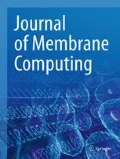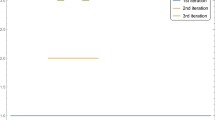Abstract
Construction of finite grammars to generate languages of digitized picture patterns, considered as arrays of symbols, has been a problem of interest in two-dimensional formal languages. On the other hand, in the area of membrane computing, P systems were developed for handling the problem of picture array generation, with the rewriting involved being sequential or parallel. We introduce in this paper the array representation for the Hilbert words, the finite approximations of the Hilbert space-filling curve, and we generate them with array-rewriting rules in P systems. The array rewriting is done in parallel, with the P system serving as a control mechanism. A main contribution is the proof of correctness which is done using a linearization procedure. In addition, the advantage of the P system used is that the number of membranes involved is small (only one or two).

Similar content being viewed by others
References
Bader, M. (2013). Space-filling curves: an introduction with applications in scientific computing, Computational Science and Engineering. Springer.
Bera, S., Pan, L., Song, B., Subramanian, K. G., & Zhang, G. (2018). Parallel contextual array P systems. International Journal of Advances in Engineering Sciences and Applied Mathematics, 10, 203–212.
Ceterchi, R., Mutyam, M., Păun, Gh, & Subramanian, K. G. (2003). Array—rewriting P systems. Natural Computing, 2, 229–249.
Ceterchi, R., Nagar, A. K., & Subramanian, K. G. (2018). Approximating polygons for space-filling curves generated with P systems, Essays Dedicated to Mario de Jesús Pérez-Jiménezon the Occasion of His 70th Birthday. Enjoying Natural Computing, 11270, 57–65.
Ceterchi, R., Nagar, A.K., & Subramanian, K.G. (2019). Chain code P system generating a variant of the Peano space-filling curve. In T. Hinze et al. (Eds.), CMC 2018 (pp. 73–83). Springer Nature, 11399.
Ceterchi, R., Subramanian, K.G., & Venkat, I. (2015). P Systems with parallel rewriting for chain code picture languages. In Proc. 11th Conference on Computability in Europe (CiE) (pp. 145–155).
Ceterchi, R., Nagar, A.K., Pan, L., & Subramanian, K.G. (2019). P systems generating array representations of Peano type space-filling curves. In Proceedings of the 20th International Conference on Membrane Computing, CMC20, August 5–8, 2019, Curtea de Argeş, Romania (Gh. Păun editor) Bibliostar, Râmnicu Vâlcea (pp. 309–324).
Ceterchi, R., & Subramanian, K.G. (2019). P systems for generating pictures in string representations: the case of space-filling curves. In Proceedings of the 20th International Conference on Membrane Computing, CMC20, August 5–8, 2019, Curtea de Argeş, Romania (Gh. Păun editor) Bibliostar, Râmnicu Vâlcea (pp. 63–80).
Ceterchi, R., & Subramanian, K. G. (2020). Generating pictures in string representations with P systems: The case of space-filling curves. Journal of Membrane Computing. https://doi.org/10.1007/s41965-020-00061-z
Ceterchi, R., Orellana-Martín, D., & Zhang, G. (2021). Division rules for P systems inspired by space-filling curves. Journal of Membrane Computing. https://doi.org/10.1007/s41965-021-00071-5
Dharani, A., Stella Maragatham, R., Nagar, A. K., & Subramanian, K. G. (2018). Chain code P system for generation of approximation patterns of Sierpiski curve. IWCIA, 11255, 43–52.
Freund, R. (2019). Playing with derivation modes. In Proceedings of the 20th international conference on membrane computing, CMC20, August 5–8, 2019, Curtea de Argeş, Romania (Gh. Păun editor) Bibliostar, Râmnicu Vâlcea, 109–122.
Freund, R. (2020). How derivation modes and halting conditions may influence the computational power of P systems. Journal of Membrane Computing, 2(1), 14–25. https://doi.org/10.1007/s41965-019-00028-9.
Giammarresi, D., & Restivo, A. (1997). Two-dimensional languages. In G. Rozenberg & A. Salomaa (Eds.), Handbook of formal languages (Vol. 3, pp. 215–267). Springer.
Hilbert, D. (1891). Über die stetige Abbildung einer Linie auf ein Flächenstück. Math. Annln., 38, 459–460.
Maurer, H. A., Rozenberg, G., & Welzl, E. (1982). Using string languages to describe picture languages. Information and Control, 54, 155–185.
Moore, E. H. (1900). On certain crinkly curves. Transactions of the American Mathematical Society, 1, 72–90.
Pan, L., Nagar, A. K., Subramanian, K. G., & Song, B. (2016). Picture array generation using flat splicing operation. Journal of Computational and Theoretical Nanoscience, 13(6), 3568–3577.
Pan, L., & Păun, Gh. (2015). On parallel array P systems, automata, universality, computation. Springer International Publishing.
Pan, L., Song, B., Isawasan, P., & Subramanian, K. G. (2016). Array P systems with parallel rewriting and tables of context-free rules. Journal of Computational and Theoretical Nanoscience, 13(6), 3636–3642.
Peano, G. (1890). Sur une courbe qui remplit toute une aire plane. Math. Annln., 36, 157–160.
Păun, Gh. (2000). Computing with membranes. Journal of Computer and System Sciences, 61, 108–143.
Salomaa, A. (1973). Formal languages. Academic Press.
Sagan, H. (1994). Space-filling curves. Springer.
Sierpiński, W. (1912). Sur une nouvelle courbe continnue qui remplit toute une aire plane, Bull. Acad. Sci. de Cracovie (Sci. math et nat., Série A), 462–478.
Siromoney, R., & Subramanian, K. G. (1983). Space-filling curves and infinite graphs. Lecture notes in comp. sci., 153, 380–391.
Subramanian, K. G. (2007). P systems and picture languages. Lecture notes in comp. sci., 4664, 99–109.
Subramanian, K. G., & Siromoney, R. (1987). On array grammars and languages. Cybernetics and Systems, 18, 77–98.
Subramanian, K. G., Venkat, I., & Pan, L. (2012). P systems generating chain code picture languages. In Proc. Asian Conf. Membrane Computing, 115–123.
Subramanian, K. G., Isawasan, P., Venkat, I., & Pan, L. (2014). Parallel array-rewriting P systems. Rom. J. Inf. Sci. Tech., 17(1), 103–116.
Subramanian, K. G., Isawasan, P., Venkat, I., Pan, L., & Nagar, A. (2014). Array P systems with permitting features. Journal of Computer Science, 5(2), 243–250.
Wunderlich, W. (1973). Über Peano-Kurven. Elemente der Mathematik, 28, 1–10.
Acknowledgements
An earlier version of this work was presented at ACMC 2019, 14-16 November 2019, Xiamen, China. The work of RC and LZ was supported by the National Natural Science Foundation of China (61772214). The work of GZ was supported by the National Natural Science Foundation of China (61972324) and by Sichuan Science and Technology Program (2021YFS0313, 2021YFG0133). The authors are greatly indebted to the reviewers for their comments and suggestions, which led to improvements, and resulted in the present form of the paper.
Author information
Authors and Affiliations
Corresponding author
Ethics declarations
Conflict of interest
On behalf of all the authors, the corresponding author states that there is no conflict of interest.
Additional information
In Memoriam Professor Rani Siromoney.
Publisher's Note
Springer Nature remains neutral with regard to jurisdictional claims in published maps and institutional affiliations.
Rights and permissions
About this article
Cite this article
Ceterchi, R., Zhang, L., Subramanian, K.G. et al. Hilbert words as arrays generated with P systems. J Membr Comput 3, 163–169 (2021). https://doi.org/10.1007/s41965-021-00078-y
Received:
Accepted:
Published:
Issue Date:
DOI: https://doi.org/10.1007/s41965-021-00078-y




